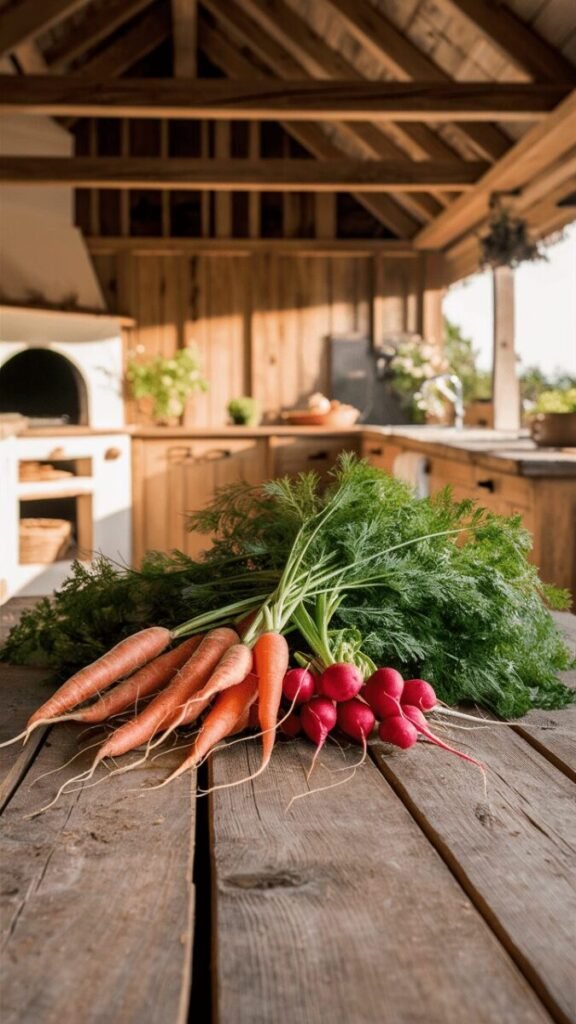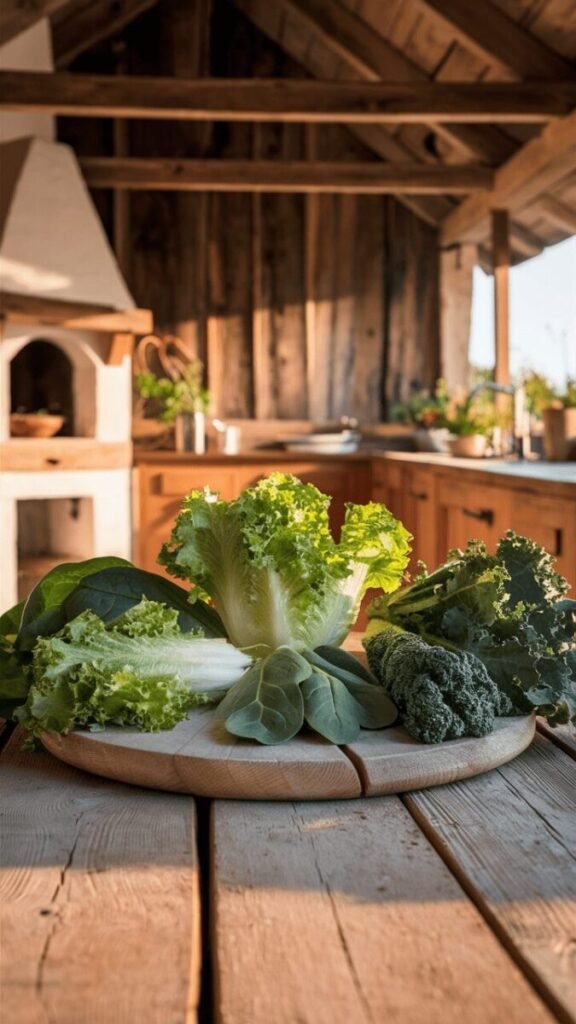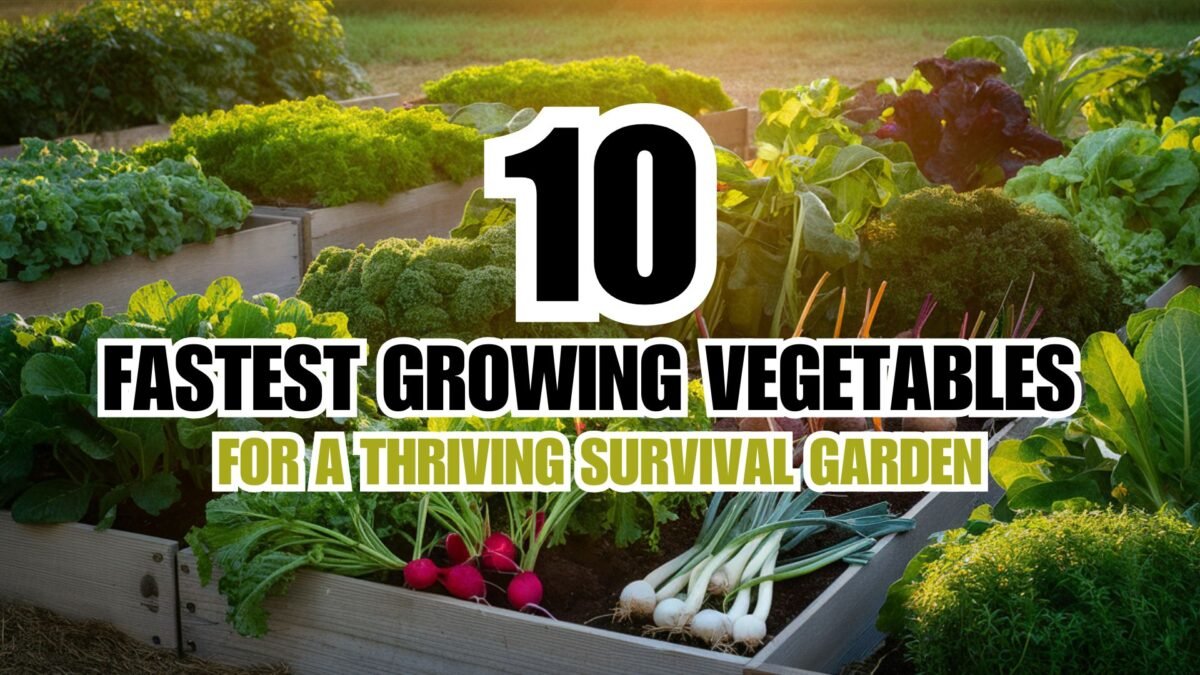In this article, learn that when every day counts in establishing a survival garden, focus on fast-maturing crops like radishes, lettuce, spinach, mustard greens, kale, beets, carrots, turnips, scallions, and arugula.
These nutritious veggies race from seed to plate in just 3-8 weeks, rapidly replenishing vital food supplies.
Check out this guide for tips on speedy gardening.
Table of Contents
What Makes a Vegetable “Fast-Growing”?
Most gardeners categorize vegetables reaching maturity within 30-60 days as fast-growing.
Not only do these speedy plants produce edible yields remarkably quickly, but their rapid lifecycle makes them ideal crops for succession planting.

By continuously replanting after each harvest, you ensure a constant flow of fresh food from a small garden footprint.
However, faster maturity often means smaller overall harvests compared to slower varieties – a trade-off worth considering based on your needs.
10 Fastest Veggies to Grow
1. Radishes

In an astonishingly swift 21-30 days, radishes provide one of the first root crop harvests. Grow these hardy, cool-weather champs in loose, well-drained soil with full sun for best results. Sow seeds 1/2 inch deep, 1 inch apart, and keep soil consistently moist until germination. Harvest promptly once roots reach full size to prevent woodiness.
Growing Tips:
- Thin seedlings to 2-3 inches apart
- Amend soil with compost or fertilizer
- Succession plant every 2 weeks for steady harvests
Nutrition Info:
| Nutrient | Amount (per 100g) |
|---|---|
| Calories | 16 kcal |
| Vitamin C | 29% DV |
| Folate | 3% DV |
| Fiber | 1.6g |
2. Lettuce
With many varieties maturing between 30-55 days, lettuce provides versatile, fast greens. Grow leaf types for the absolute quickest harvests or opt for romaine and head varieties for larger yields over a longer period. Lettuce prefers cool conditions with consistent moisture and partial shade in hot climates.
Growing Tips:
- Sow seeds 1/4 inch deep, thin to 8-12 inches apart
- Fertilize regularly with balanced vegetable food
- Cut entire heads at soil level or harvest outer leaves
Varieties:
- Leaf: Black Seeded Simpson, Red Sails, Salad Bowl
- Romaine: Parris Island Cos, Valmaine
- Head: Iceberg, Buttercrunch, Boston
Nutrition Info:
| Nutrient | Amount (per 100g) |
|---|---|
| Calories | 15 kcal |
| Vitamin A | 470% DV |
| Vitamin K | 171% DV |
| Folate | 17% DV |
3. Spinach
This cool-season green packs a nutrient punch while maturing rapidly in just 30-45 days. Spinach thrives in fertile, well-drained soil with ample moisture and some afternoon shade from scorching sun. Direct sow seeds or start indoors for an early crop, then harvest outer leaves or the entire plant.
Growing Tips:
- Sow 1/2 inch deep, thin to 4-6 inches apart
- Mulch to retain moisture; consider self-watering containers
- Choose heat-tolerant varieties for extended harvests
Nutrition Info:
| Nutrient | Amount (per 100g) |
|---|---|
| Calories | 23 kcal |
| Vitamin K | 604% DV |
| Vitamin A | 56% DV |
| Manganese | 30% DV |
| Folate | 15% DV |
4. Mustard Greens
Hardy mustard greens bring a peppery bite to the garden while reaching maturity in just 30-50 days. This cool-season crop tolerates heat better than many greens, but still prefers spring and fall conditions with consistent moisture. Sow seeds directly or start transplants inside.
Growing Tips:
- Sow 1/4 inch deep, thin to 6-8 inches apart
- Provide nutrient-rich soil; mustards are heavy feeders
- Harvest outer leaves or cut entire plants at base
Nutrition Info:
| Nutrient | Amount (per 100g) |
|---|---|
| Calories | 25 kcal |
| Vitamin K | 436% DV |
| Vitamin A | 59% DV |
| Vitamin C | 47% DV |
| Folate | 15% DV |
5. Kale

Packed with vitamins and minerals, kale varieties like curly and lacinato reach maturity in only 30-60 days. This cool-weather crop grows best in fertile, well-drained soil with partial afternoon shade to prevent bitter flavors. Start seeds indoors or direct sow once soil warms up.
Growing Tips:
- Sow 1/2 inch deep, thin to 12-18 inches apart
- Mulch to retain moisture; avoid drought stress
- Consider raised beds for better drainage
Varieties:
- Curly: Vates, Dwarf Blue Curled
- Lacinato: Dinosaur, Black Magic
- Red/Purple: Red Russian, Redbor
Nutrition Info:
| Nutrient | Amount (per 100g) |
|---|---|
| Calories | 49 kcal |
| Vitamin K | 684% DV |
| Vitamin A | 206% DV |
| Vitamin C | 88% DV |
| Manganese | 26% DV |
6. Beets
In just 45-60 days, beets provide both nutrient-dense roots and tasty greens for eating. These cool-season veggies thrive in loose, well-drained soil with full sun exposure. Sow seeds directly or start transplants inside about 4 weeks before the last frost date.
Growing Tips:
- Sow 1/2 inch deep, thin to 3-4 inches apart
- Keep soil moist but avoid overwatering
- Harvest beet roots when shoulders emerge, leaving greens
Using Roots & Greens:
- Roast, pickle, or add roots to salads and soups
- Sauté or blend beet greens into smoothies and sautés
Nutrition Info (Roots):
| Nutrient | Amount (per 100g) |
|---|---|
| Calories | 43 kcal |
| Folate | 20% DV |
| Manganese | 16% DV |
| Vitamin C | 6% DV |
| Fiber | 2.8g |
7. Carrots
Sweet and crunchy, carrots take slightly longer at 50-70 days to size up their roots. These sun-loving veggies prefer loose, sandy soil for straight growth. Sow carrot seeds about 1/4 inch deep and keep soil surface consistently moist until seedlings emerge.
Growing Tips:
- Thin to 2-3 inches apart in rows
- Use seed tapes or pellets for easier sowing
- Mulch to retain moisture and suppress weeds
Varieties:
- Nantes: Cylindrical, sweet roots
- Chantenay: Short, thick for heavy soils
- Imperator: Long tapered roots for deep, loose soils
Nutrition Info:
| Nutrient | Amount (per 100g) |
|---|---|
| Calories | 41 kcal |
| Vitamin A | 428% DV |
| Vitamin K | 16% DV |
| Fiber | 2.8g |
| Potassium | 6% DV |
8. Turnips
Both the roots and nutrient-rich greens of turnips reach harvestable size in a quick 40-60 days. These cool-season crops prefer full sun and well-drained soil. Sow seeds directly or start transplants indoors about 4 weeks before the last frost.
Growing Tips:
- Sow 1/2 inch deep, thin to 4-6 inches apart
- Provide consistent moisture and fertile soil
- Leave greens to regrow after root harvest
Using Roots & Greens:
- Roast, mash, or add turnip roots to stews
- Sauté or add greens to salads and stir-fries
Nutrition Info (Roots):
| Nutrient | Amount (per 100g) |
|---|---|
| Calories | 28 kcal |
| Vitamin C | 33% DV |
| Fiber | 1.8g |
| Folate | 5% DV |
| Potassium | 8% DV |
9. Scallions/Green Onions

Flavorful alliums like scallions need only 30-60 days to reach full size, adding zest to dishes with green tops and mild white bases. Perfect for containers or gardens, they regrow readily when harvested correctly. Sow seeds thickly for a constant supply.
Growing Tips:
- Sow 1/4 inch deep, thin to 2-4 inches apart
- Provide fertile soil and consistent moisture
- Harvest by cutting green tops, leaving roots
Using for Flavoring:
- Add both tops and bottoms to stir-fries, soups, salads
- Chop and freeze extras for later use
- Try growing in water for zero-space harvests
Nutrition Info:
| Nutrient | Amount (per 100g) |
|---|---|
| Calories | 32 kcal |
| Vitamin K | 103% DV |
| Vitamin C | 58% DV |
| Folate | 9% DV |
| Potassium | 4% DV |
10. Arugula
With its distinctive peppery bite, nutrient-packed arugula greens race to maturity in only 30-40 days. This cool-season annual grows best in well-drained soil with full sun to partial shade. Sow seeds directly or start transplants inside about 4 weeks before last frost.
Growing Tips:
- Sow 1/4 inch deep, thin to 6-8 inches apart
- Provide fertile soil and consistent moisture
- Harvest outer leaves regularly or cut full plants
Distinctive Flavor:
- Adds a nutty, peppery kick to salads and sandwiches
- Sauté or wilt into pasta dishes, soups, pizzas
- Pairs well with bold flavors like garlic and lemon
Nutrition Info:
| Nutrient | Amount (per 100g) |
|---|---|
| Calories | 25 kcal |
| Vitamin K | 90% DV |
| Vitamin A | 20% DV |
| Folate | 16% DV |
| Calcium | 8% DV |
Succession Planting Tips
To keep those rapid harvests rolling in, use succession planting by sowing new crops every 2-4 weeks. As mature plants finish, immediately replant that space with a new round of fast crops. Stagger varieties by selecting some early and late-season cultivars to extend the total harvest window.
For example, start with cold-hardy greens like arugula and radishes. Once temperatures warm, transition to heat-tolerant lettuces and mustards while sowing warm-season crops like beans and squash elsewhere. With strategic timing, you’ll ensure a steady supply of fresh food from spring through fall.
Conclusion
When survival is on the line, fast-growing vegetables provide the rapid food returns every crisis garden needs. By focusing your efforts on crops like radishes, greens, and root veggies that race from seed to plate in just a month or two, you maximize yields from limited space. Pair these speedy winners with calorie crops and succession planting techniques to build a highly productive survival garden. Start sowing these top 10 fastest veggie varieties today for a thriving source of fresh, nutrient-dense foods!


